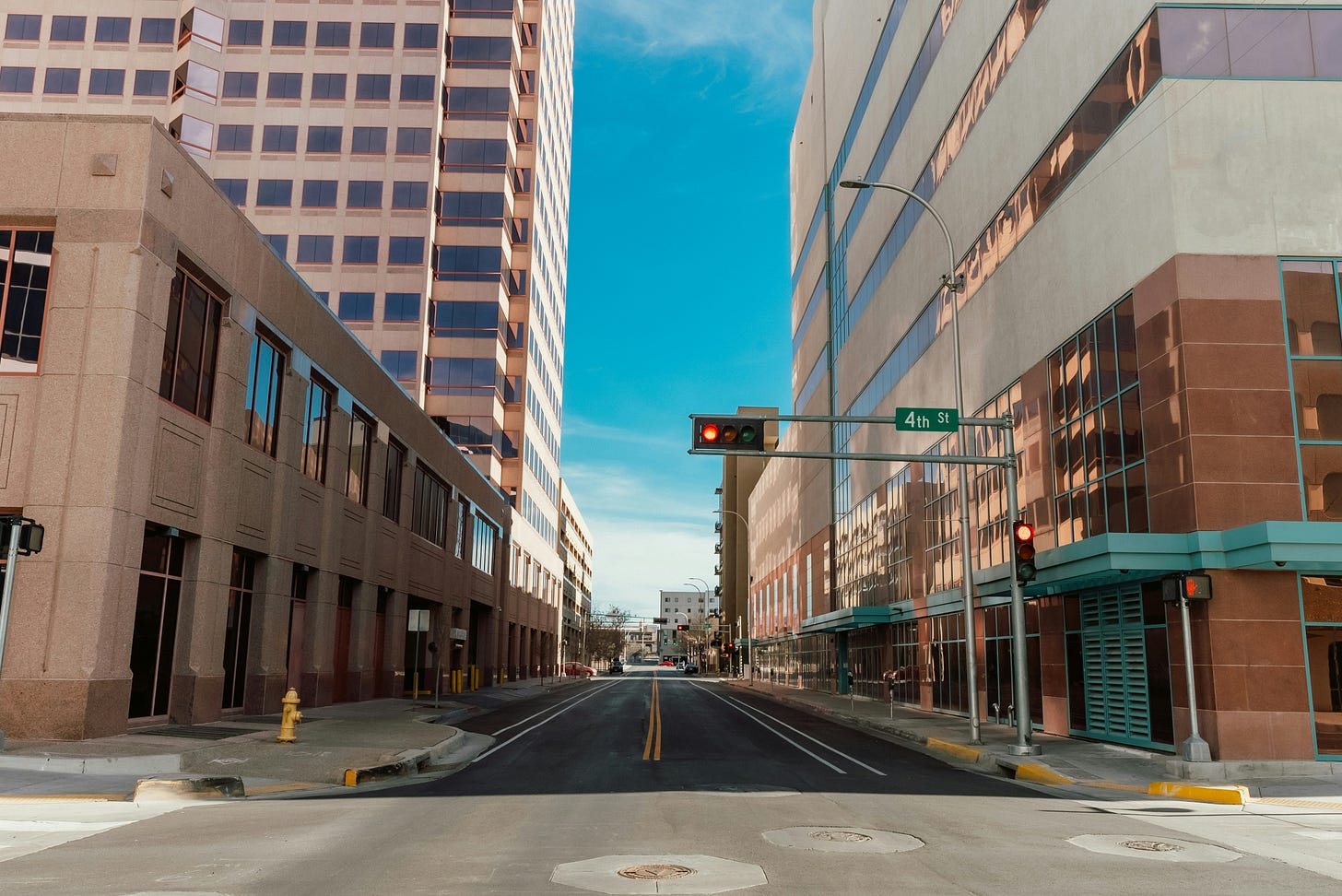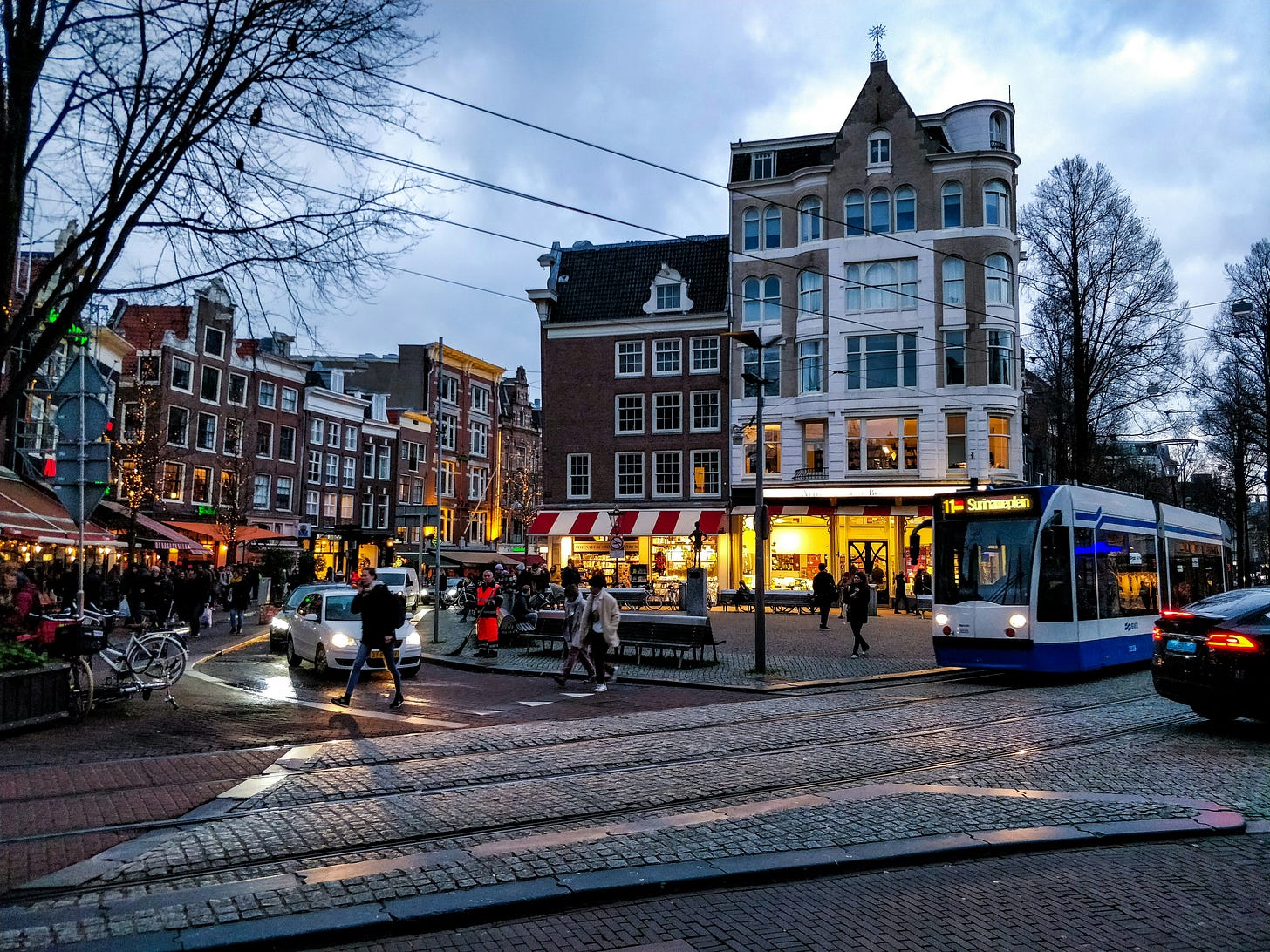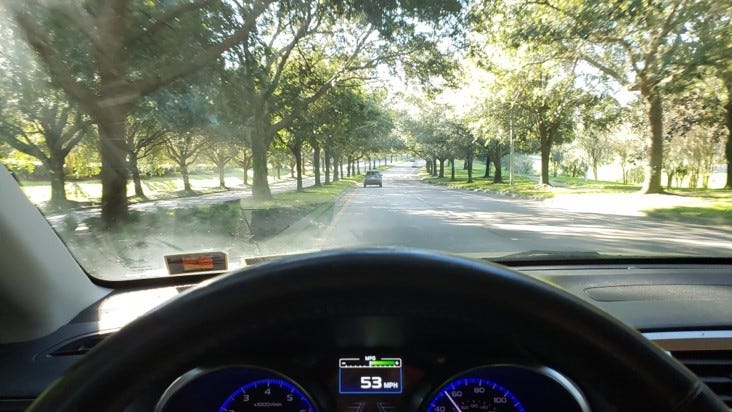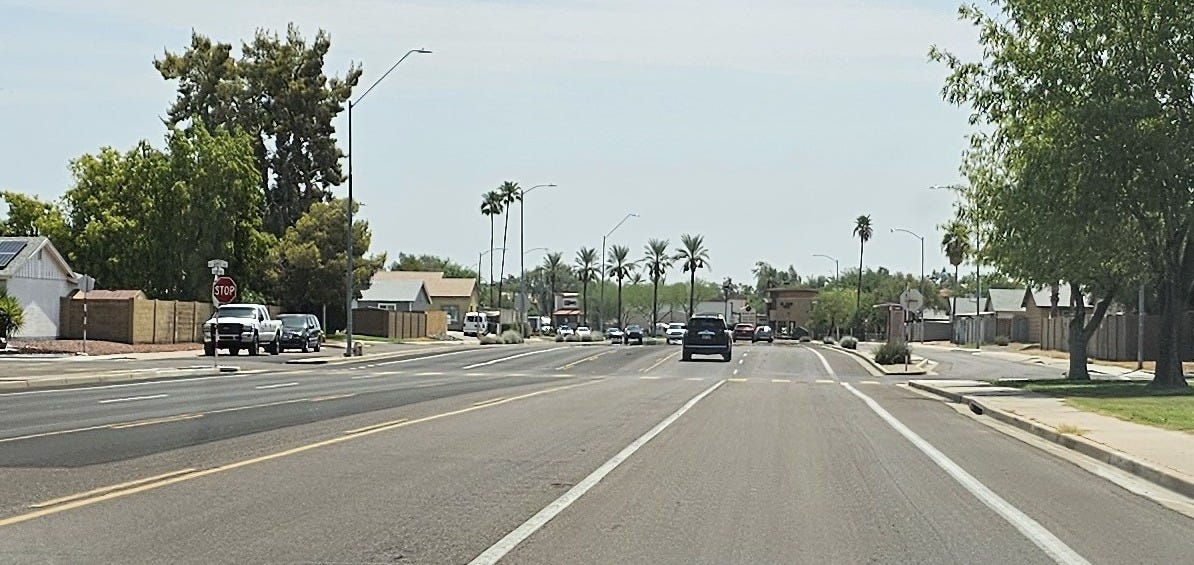The truth is that we don’t have really strong definitions for these terms. Like the Supreme Court Justice, Potter Stewart: it might be hard to define, but “I know it when I see it.” That really isn’t good enough for anyone who is actually trying to build a better world.
Defining a Street, a Road, and a StRoad
Even Oxford is not much help:
Road: a hard surface built for vehicles to travel on.
Well, that explains it. (Really?? You could try harder). At least it does emphasize that roads are for vehicles. Oxford does give us a good start for a street:
Street: a public road in a city or town that has buildings on one or both sides.
But even that can go awry. You mean like this?
That doesn’t look like a very good street, even if it fits the definition.
According to the Urban Dictionary, here’s the definition for a StRoad:
StRoad: Stroad is an unofficial slang portmanteau of street + road. It refers to roads that do a dangerous job of combining the features of a street and a road.
What we need is a definition at a functional level. What are streets, roads, and stroads supposed to do? How would they impact the community or make people feel?
I think we can get a lot closer when we take a human factors approach. If we understand how a street makes people respond, we’ll have a better chance of recognizing them when we see (or create) them. Since human factors, community connection, and engineering are all my jam, here’s my attempt:
Street: The transportation spaces where the community generates value at a face-to-face scale, on which all conflicts are consistently negotiated eye to eye.
How about this for a road:
Road: the links that transport people in large vehicles long distances at high speeds to reach high value destinations.
In a modern world, we need a few of these and they don’t have to be sewers. I love this one:
The segment is several miles long (and looks this great nearly the whole way). It’s perfectly fine to do this speed. There are multi-use paths on the other side of the trees, but if you go off the road, because you’re drunk, stupid, or have a vehicle problem, you’re not going to hit anyone. It’s fine. There’s curbs to steer you out of the way and a bit of recovery room on the side if you really need it. If I remember correctly, we haven’t even had any fatalities, despite the clear violation of clear zone standards.
How about a StRoad definition, just to round things out:
StRoad: the accidental roadway design compromise that sucks value out of communities. It connects vehicles and doorways, but not people and doorways.
No one intends a StRoad to happen. They happen when people get in a room and fight for their own rights, and no one leaves happy. It’s a lose-lose outcome, both in the short term and the long term. The land uses along a StRoad are usually a bad value for the community—they take up a lot of land in return for a relatively small amount of property taxes. Because they require a bunch of land and long distances, serving them with utilities is expensive, both in the initial construction and in long term maintenance. Most city officials will puff out their chests proudly and tell you that they made the developer carry those initial costs, but it's a fool's bargain—Jack and the beans, but the beans are a dud: no beanstalk. Besides the fact that those costs will get passed on to the customers that live in that community, that infrastructure the developer just built for you is not an asset but a liability. It will cost you dearly in maintenance over the long haul—you may have just bankrupted your town. You’ll get tax revenue from them, for a few years, before they fall apart and become blighted shells, but you won’t break even when you get to the maintenance costs.
From a safety standpoint, there’s a much bigger problem. StRoads look deceptively safe for pedestrians and cyclists. Many a well-meaning DOT engineer will get railroaded into putting a bike lane there. If they took even a moment to think that through, they would have rightly pushed back because there’s no one who would think that it’s safe enough for the users that the law says are to be served. Engineers are supposed to be the one group in our world who has the right to tell their client they can’t do something because it’s not safe.
How did we talk a bunch of engineers into thinking this was ok? Would it be ok for a child? Children are legally obligated to use these facilities if they live within the walk-shed of a school. The level of unreality boggles the mind.
How is that working for you?
Unfortunately, it’s time for some tough love. The first step to correcting the problem is to recognize it as a problem. It’s ok to have a street. It’s even ok to have a road. StRoads set people up with impossible choices that will ultimately kill people.
I was speaking with several folks from NACTO yesterday. The question they get the most is the problem of how to deal with speed management on arterials. I’m not sure you can. You’re not going to be able to turn most StRoads into streets. You can create small sections where the crossings are clear enough to be able to cross them, but if your goal is to move large volumes of regional traffic, trying to get drivers to slow down is counter-productive. The sooner we deal with that reality, the better. You might be able to turn them into a really good road and put a street nearby, but until we insist on clarity, we will keep killing people in these ugly compromises.
I spent some time last year looking at the night-time fatalities around the country. What I saw broke my heart. About 2/3 of them were between 6 and 10 pm. When you looked at the Streetview for the crash locations the pattern was clear: a shopping center on one side of a 5+ lane road and an apartment complex on the other. This is what our “Roads for families” looks like in the US, and it’s not ok.
I added a new video to my YouTube page yesterday. It’s a talk I gave at the International Road Foundation last year. It’s one of the first times I publicly talked about a flowchart for determining how to remediate a StRoad. There’s a lot of giving up on this chart. We can fix things, but we won’t be able to fix them overnight. We didn’t get here overnight.
Ultimately the biggest successes are going to come where we can begin to add network back into the system. That’s the only way we can have both streets and roads that do what they’re designed to do. We end up needing to have big roads because we don’t have the redundancy and connectivity that the good old street grid gave us—and not that fake street grid that only connects up in a few spots. If your access management strategy limits those connections, you’re never going to get a slower speed on anything. It’s a congestion trap and a self-fulfilling prophecy of doom.
Suburban Retrofits
Ellen Dunham-Jones’ work can help. She has an entire catalogue of clever ways to reuse and redesign old suburban strip shopping centers or malls—creating truly gridded networks. This can make a big difference. One thing that most public agencies don’t realize is that most commercial loans are balloon loans: they have to be renegotiated every 5 to 10 years. When the owner goes to get a new loan, they have to prove that it’s worth the amount they’re asking for, which often means major upgrades. This is a prime opportunity to reconfigure these sites into something that will solve problems instead of create them—if you know how to take advantage of that opportunity. The same things happen on the public sector side with roadway repaving or reconstruction. If you’re prepared, you can undo what is broken in your normal maintenance cycles and not spend much more than you were going to spend anyway.
Street StRoad Bingo!!!
Next week at CNU, we’re playing Street and StRoad Blackout Bingo!!! This is one of my favorite presentation activities because it always stimulates a lot of discussion, a bunch of giggles, a lot of head-shaking, and a handful of paradigm breakthroughs. Doing this with an entry-level CNU crowd should be an absolute blast.
I was introduced to StRoad Bingo by Stephen Ratke at FHWA, and he picked it up from the CityNerd, Ray Delhanty, who did a spectacular video on the StRoad version. We did this at T-Camp in DC two years ago and it was one of the best learning experiences I’ve ever led. It’s one thing to call out what’s wrong about something, but another thing entirely to show off what’s right—which meant we had to have a list of street characteristics to go with the ones that Ray and Stephen picked out.
If you want to play along in advance here are the links:
Up next:
Next week is CNU week, which starts out with the Strong Towns National Gathering and then bleeds over into my favorite conference of the year. This is the one I will go to even if I'm not speaking (I got scolded for that last year, so I'll try not to do that again). The week is jam packed with loads of inspiration and transformation and I love every minute.
I'm going on the tour of Mashpee Commons, the original suburban retrofit, and hoping to take lots of pictures!!! If I get something out next week, it's likely to be later in the day on Friday—we'll see.
Of course, there's also the book release for The Art of the New Urbanism, compiled by my good friend, Victor Dover, James Bohl, and the incomperable James Dogherty. It's a huge coffee table book of Charette Artwork, which is always so beautiful—most of them worthy of framing. They belong in a gallery, but are often made on the fly in planning meetings, where the community is rethinking their future. They are the embodiment of hope.
The coolest part is that most of the contributors will be there—which means a room full of book signings, like getting everyone together to sign your yearbook. I'm totally planning on going all fan-girl, so I’m likely to flood social media with a pile of selfies by the end of the week. (Eeeeee!)
It's gonna be so much fun!!! If you're there, don't hesitate to stop me and I'll do a selfie with you too!!









